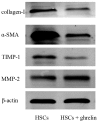Ghrelin Attenuates Liver Fibrosis through Regulation of TGF-β1 Expression and Autophagy
- PMID: 26378522
- PMCID: PMC4613288
- DOI: 10.3390/ijms160921911
Ghrelin Attenuates Liver Fibrosis through Regulation of TGF-β1 Expression and Autophagy
Abstract
Ghrelin is a stomach-derived growth hormone secretagogue that promotes various physiological effects, including energy metabolism and amelioration of inflammation. The purpose of this study was to investigate the protective mechanism of ghrelin against liver fibrosis. Liver fibrosis was induced in C57BL/6 mice by intraperitoneal injection of CCl₄ (2.0 mL/kg of 10% CCl₄ v/v solution in peanut oil) two times per week for eight weeks. Ghrelin (10 μg/kg) was intraperitoneally injected two times per week for eight weeks. A second murine liver fibrosis model was induced by bile duct ligation (BDL) and concurrent ghrelin administration for four weeks. Hematoxylin eosin (H&E), and Masson's trichrome were used to detect pathological changes to liver tissue. Western blotting was used to detect protein levels of transforming growth factor (TGF)-β1, phosphorylated Smad3 (p-Smad3), I-collage, α-smooth muscle actin (α-SMA), matrix metalloproteinases (MMPs) 2, tissue inhibitor of matrix metalloproteinases (TIMPs) 1, phosphorylated NF-κB (p-NF-κB), and microtubule-associated protein light chain 3 (LC3). In addition, qRT-PCR was used to detect mRNA levels of TGF-β1, I-collage, α-SMA, MMP2, TIMP1 and LC3, while levels of TGF-β1, p-Smad3, I-collage, α-SMA, and LC3 were detected immunohistochemically. Levels of aspartate aminotransferase and alanine aminotransferase were significantly decreased by ghrelin treatment. Ghrelin administration also significantly reduced the extent of pathological changes in both murine liver fibrosis models. Expression levels of I-collage and α-SMA in both models were clearly reduced by ghrelin administration. Furthermore, ghrelin treatment decreased protein expression of TGF-β1 and p-Smad3. The protein levels of NF-κB and LC3 were increased in the CCl₄- and BDL-treatment groups but were significantly reduced following ghrelin treatment. In addition, ghrelin inhibited extracellular matrix formation by decreasing NF-κB expression and maintaining the balance between MMP2 and TIMP1. Our results demonstrated that ghrelin attenuates liver fibrosis via inhibition of the TGF-β1/Smad3 and NF-κB signaling pathways, as well as autophagy suppression.
Keywords: CCl4; NF-κB; TGF-β1-Smad; autophagy; bile duct ligation; fibrosis; ghrelin; hepatic stellate cells.
Figures











Similar articles
-
Ampelopsin attenuates carbon tetrachloride-induced mouse liver fibrosis and hepatic stellate cell activation associated with the SIRT1/TGF-β1/Smad3 and autophagy pathway.Int Immunopharmacol. 2019 Dec;77:105984. doi: 10.1016/j.intimp.2019.105984. Epub 2019 Oct 31. Int Immunopharmacol. 2019. PMID: 31677501
-
Liuweiwuling tablets attenuate BDL-induced hepatic fibrosis via modulation of TGF-β/Smad and NF-κB signaling pathways.J Ethnopharmacol. 2018 Jan 10;210:232-241. doi: 10.1016/j.jep.2017.08.029. Epub 2017 Aug 31. J Ethnopharmacol. 2018. PMID: 28864168
-
Caffeic acid phenethyl ester attenuates liver fibrosis via inhibition of TGF-β1/Smad3 pathway and induction of autophagy pathway.Biochem Biophys Res Commun. 2017 Apr 22;486(1):22-28. doi: 10.1016/j.bbrc.2017.02.057. Epub 2017 Feb 11. Biochem Biophys Res Commun. 2017. PMID: 28193525
-
Activation of Nrf2/AREs-mediated antioxidant signalling, and suppression of profibrotic TGF-β1/Smad3 pathway: a promising therapeutic strategy for hepatic fibrosis - A review.Life Sci. 2020 Sep 1;256:117909. doi: 10.1016/j.lfs.2020.117909. Epub 2020 Jun 5. Life Sci. 2020. PMID: 32512009 Review.
-
Role of Platelet-Derived Transforming Growth Factor-β1 and Reactive Oxygen Species in Radiation-Induced Organ Fibrosis.Antioxid Redox Signal. 2017 Nov 1;27(13):977-988. doi: 10.1089/ars.2017.7064. Epub 2017 Jul 5. Antioxid Redox Signal. 2017. PMID: 28562065 Free PMC article. Review.
Cited by
-
Molecular and cellular mechanisms underlying the hepatoprotective role of ghrelin against NAFLD progression.J Physiol Biochem. 2023 Nov;79(4):833-849. doi: 10.1007/s13105-022-00933-1. Epub 2022 Nov 22. J Physiol Biochem. 2023. PMID: 36417140 Review.
-
Activation of mTORC1 signaling in gastric X/A-like cells induces spontaneous pancreatic fibrosis and derangement of glucose metabolism by reducing ghrelin production.EBioMedicine. 2018 Oct;36:304-315. doi: 10.1016/j.ebiom.2018.09.027. Epub 2018 Sep 25. EBioMedicine. 2018. PMID: 30266297 Free PMC article.
-
Quercetin prevents hepatic fibrosis by inhibiting hepatic stellate cell activation and reducing autophagy via the TGF-β1/Smads and PI3K/Akt pathways.Sci Rep. 2017 Aug 24;7(1):9289. doi: 10.1038/s41598-017-09673-5. Sci Rep. 2017. PMID: 28839277 Free PMC article.
-
MicroRNA-29a Exhibited Pro-Angiogenic and Anti-Fibrotic Features to Intensify Human Umbilical Cord Mesenchymal Stem Cells-Renovated Perfusion Recovery and Preventing against Fibrosis from Skeletal Muscle Ischemic Injury.Int J Mol Sci. 2019 Nov 22;20(23):5859. doi: 10.3390/ijms20235859. Int J Mol Sci. 2019. PMID: 31766662 Free PMC article.
-
Cinnamomum osmophloeum Kanehira ethanol extracts prevents human liver-derived HepG2 cell death from oxidation stress by induction of ghrelin gene expression.J Biosci. 2017 Sep;42(3):439-448. doi: 10.1007/s12038-017-9697-2. J Biosci. 2017. PMID: 29358557
References
-
- Friedman S.L. The cellular basis of hepatic fibrosis—Mechanisms and treatment strategies. N. Engl. J. Med. 1993;328:1828–1835. - PubMed
Publication types
MeSH terms
Substances
LinkOut - more resources
Full Text Sources
Other Literature Sources
Medical
Research Materials
Miscellaneous

